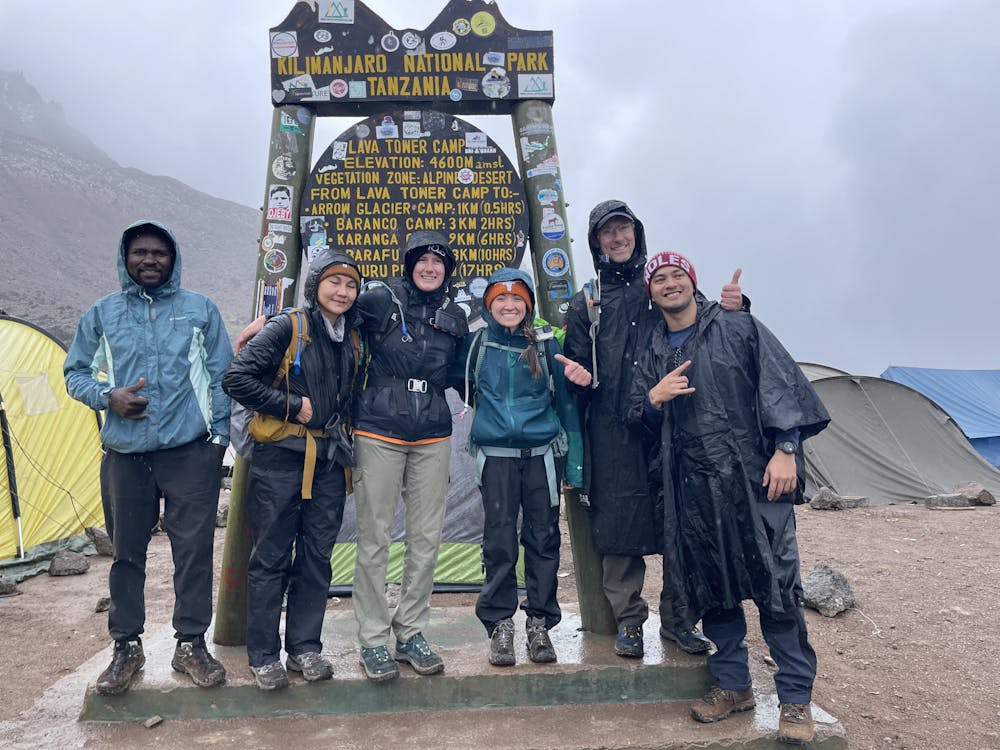While most University students sought familiar comforts over winter break, returning to their beds, pets and home-cooked meals, two students explored new terrain by climbing the tallest free-standing mountain in the world — Mount Kilimanjaro.
Located in Tanzania’s Kilimanjaro National Park, Mt. Kilimanjaro stands at 19,340 feet as the tallest mountain in Africa, making it one of the Seven Summits. Third-year Engineering student Scout Bale and fourth-year Engineering student Justin Brady decided to take on the challenge of hiking to its summit late last December. Although the two students hiked the mountain separately, their shared University origins, ambitions and achievements sewed common threads through their respective journeys.
The decision to climb Mt. Kilimanjaro is hardly inconsequential, but it came easily for Bale. She described it as spur-of-the-moment — something to pass the time during her travels in Africa.
“I was just visiting my grandma and looking for some things to do,” Bale said. “And I like climbing mountains. So I decided to do that one.”
Brady’s climbing adventure, on the other hand, fulfilled a long-awaited goal. He and his father had talked about climbing Mt. Kilimanjaro for years.
“The idea came from my dad first — he'd been trying to do it for a couple of years,” Brady said. “When he first wanted to do it, I was too young, so this year, I decided to tag along. Six to eight months ago, [the two of us] just decided to book the trip and do it over winter break.”
From the onset of their week-long climbs, both students experienced a routine completely different from a normal day on Grounds. Bale observed how her fellow climbers restructured their daily plans to accommodate the extreme conditions on Mt. Kilimanjaro.
“You usually start by [asking], ‘What layers do I need?’ Like rain gear, lots of fleeces, a base layer or not,” Bale said. “And then you have to make sure you have enough water. It was pretty incredible to see what people can do on the side of a mountain.”
Brady also described how hiking the mountain exposed him to a new lifestyle.
“I just think the mountain is a really cool environment,” Brady said. “Getting to see Africa in general was really cool. It's very different from how you live here in the U.S.”
The first time climbers summited Mt. Kilimanjaro was in 1889. Since then, an estimated 35,000 climbers have attempted the trek each year. However, only about two-thirds of people are successful, with altitude-related problems being the leading cause of failed attempts. Brady confirmed that the high altitude posed a challenge when he and his father neared the summit.
“I definitely had some altitude sickness, especially on the summit day,” Brady said. “I got a bloody nose that didn't stop for 20 minutes — just because the air is so thin and dry up there.”
On Mt. Kilimanjaro, climbers encounter five different climate zones and must pack several layers to prepare for fluctuations in temperature. Brady shared his fascination with the variations in weather and landscape.
“You go through all these different environments as you move your way up the mountain,” Brady said. “I thought that was really interesting — you start in a rainforest, and by the time you're at the top, it's covered in snow.”
Both students were accompanied by porters — people who travel alongside climbers, prepare routes and carry excess gear. The porters also supplied Brady and Bale with robust multiple-course meals that gave them the energy they needed for the demanding journey. Proper fuel was essential — each day on the mountain consisted of anywhere from four to eight hours of hiking.
“You get a lot of food,” said Bale. “They [were] really trying to pack the calories in.”
Bale emphasized how her porters alleviated much of the physical burden of the climb, allowing her to enjoy the week-long journey.
“They do pretty much everything for you — it was very fancy mountain climbing,” Bale said. “I did not have to carry more than my water for the day, or my rain layers, or a jacket. And I did not carry any of my own food or sleeping gear. Anything that I didn't need for that specific day I could put in a bag and someone else would carry for me.”
In total, the journey took seven days — five days up and two days down. For Brady and Bale, the summit day was the longest and most difficult of the climb. It was a day of steep elevation, emotion and exhaustion.
“There was a flood of emotion when I saw that final sign and realized I finally made it,” Brady said. “Especially after the eight hours of hiking to get to the summit, there was just a flood of relief to finally be able to say, ‘I am standing on the top of Africa right now.’”
In reflecting on their journey, Brady and Bale both described the climb as an invaluable trek that they would recommend to anyone, regardless of their climbing experience.
“I think it's definitely doable for just about anyone,” Brady said. “It's really just a once-in-a-lifetime experience. I don't know that I'll ever be back there again, so just having had that experience was really cool. I think a lot of people would appreciate it, even if they're not that into hiking.”
While Grounds — at an elevation of around 466 feet — cannot quite rival the height of Mt. Kilimanjaro, Brady and Bale continue to channel their climbers’ spirit at the University. Having traveled to a different continent and conquered its highest point, the two students highlight a valuable practice — the ability to step back from bustling society and see the world from a different angle, even if that means from thousands of feet above the ground.







